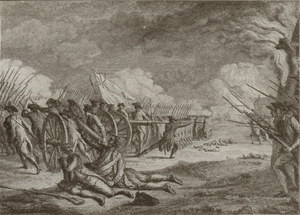Lexington and Concord
| Battles of Lexington and Concord | |||||||
|---|---|---|---|---|---|---|---|
| Part of the American Revolutionary War | |||||||
 Romanticized 19th-century depiction of Battle of Lexington |
|||||||
|
|||||||
| Belligerents | |||||||
|
|
|
||||||
| Commanders and leaders | |||||||
|
John Parker James Barrett John Buttrick John Robinson William Heath Joseph Warren Isaac Davis † |
Francis Smith John Pitcairn (WIA) Hugh Percy |
||||||
| Strength | |||||||
|
Lexington: 77 Concord: 400 End of Battle: 3,960 |
Departing Boston: 700 Lexington: 400 Concord: 100 End of Battle: 1,500 |
||||||
| Casualties and losses | |||||||
| 49 killed 39 wounded 5 missing |
73 killed 174 wounded 53 missing |
||||||
Strategic American victory
The Battles of Lexington and Concord were the first military engagements of the American Revolutionary War. The battles were fought on April 19, 1775 in Middlesex County, Province of Massachusetts Bay, within the towns of Lexington, Concord, Lincoln, Menotomy (present-day Arlington), and Cambridge. They marked the outbreak of armed conflict between the Kingdom of Great Britain and its thirteen colonies in America.
In late 1774, Colonial leaders adopted the Suffolk Resolves in resistance to the alterations made to the Massachusetts colonial government by the British parliament following the Boston Tea Party. The colonial assembly responded by forming a Patriot provisional government known as the Massachusetts Provincial Congress and calling for local militias to train for possible hostilities. The Colonial government exercised effective control of the colony outside of British-controlled Boston. In response, the British government in February 1775 declared Massachusetts to be in a state of rebellion.
About 700 British Army regulars in Boston, under Lieutenant Colonel Francis Smith, were given secret orders to capture and destroy Colonial military supplies reportedly stored by the Massachusetts militia at Concord. Through effective intelligence gathering, Patriot leaders had received word weeks before the expedition that their supplies might be at risk and had moved most of them to other locations. On the night before the battle, warning of the British expedition had been rapidly sent from Boston to militias in the area by several riders, including Paul Revere, with information about British plans. The initial mode of the Army's arrival by water was signaled from the Old North Church in Boston to Charleston using lanterns to communicate "one if by land, two if by sea".
...
Wikipedia
